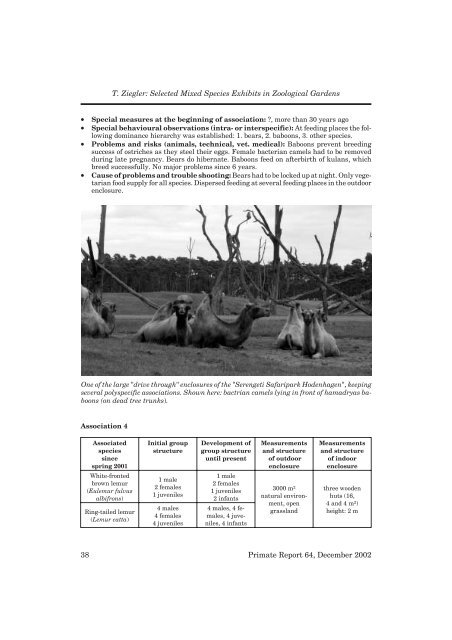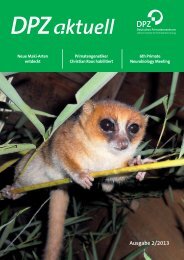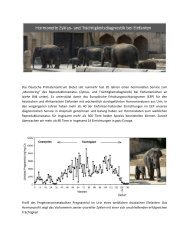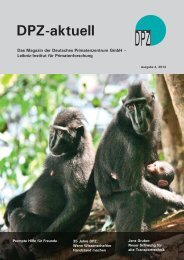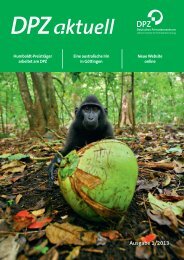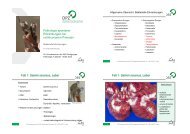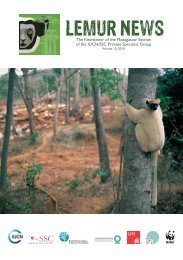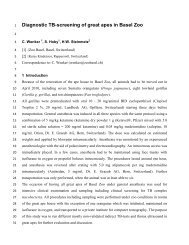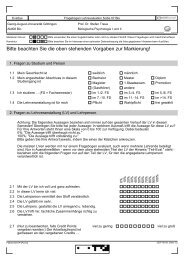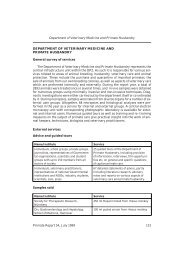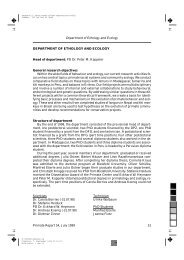Selected Mixed Species Exhibits of Primates in German ... - DPZ
Selected Mixed Species Exhibits of Primates in German ... - DPZ
Selected Mixed Species Exhibits of Primates in German ... - DPZ
You also want an ePaper? Increase the reach of your titles
YUMPU automatically turns print PDFs into web optimized ePapers that Google loves.
• Special measures at the beg<strong>in</strong>n<strong>in</strong>g <strong>of</strong> association: ?, more than 30 years ago<br />
• Special behavioural observations (<strong>in</strong>tra- or <strong>in</strong>terspecific): At feed<strong>in</strong>g places the follow<strong>in</strong>g<br />
dom<strong>in</strong>ance hierarchy was established: 1. bears, 2. baboons, 3. other species.<br />
• Problems and risks (animals, technical, vet. medical): Baboons prevent breed<strong>in</strong>g<br />
success <strong>of</strong> ostriches as they steel their eggs. Female bacterian camels had to be removed<br />
dur<strong>in</strong>g late pregnancy. Bears do hibernate. Baboons feed on afterbirth <strong>of</strong> kulans, which<br />
breed successfully. No major problems s<strong>in</strong>ce 6 years.<br />
• Cause <strong>of</strong> problems and trouble shoot<strong>in</strong>g: Bears had to be locked up at night. Only vegetarian<br />
food supply for all species. Dispersed feed<strong>in</strong>g at several feed<strong>in</strong>g places <strong>in</strong> the outdoor<br />
enclosure.<br />
Association 4<br />
Associated<br />
species<br />
s<strong>in</strong>ce<br />
spr<strong>in</strong>g 2001<br />
White-fronted<br />
brown lemur<br />
(Eulemur fulvus<br />
albifrons)<br />
R<strong>in</strong>g-tailed lemur<br />
(Lemur catta)<br />
T. Ziegler: <strong>Selected</strong> <strong>Mixed</strong> <strong>Species</strong> <strong>Exhibits</strong> <strong>in</strong> Zoological Gardens<br />
One <strong>of</strong> the large "drive through" enclosures <strong>of</strong> the "Serengeti Safaripark Hodenhagen", keep<strong>in</strong>g<br />
several polyspecific associations. Shown here: bactrian camels ly<strong>in</strong>g <strong>in</strong> front <strong>of</strong> hamadryas baboons<br />
(on dead tree trunks).<br />
Initial group<br />
structure<br />
1 male<br />
2 females<br />
1 juveniles<br />
4 males<br />
4 females<br />
4 juveniles<br />
Development <strong>of</strong><br />
group structure<br />
until present<br />
1 male<br />
2 females<br />
1 juveniles<br />
2 <strong>in</strong>fants<br />
4 males, 4 females,<br />
4 juveniles,<br />
4 <strong>in</strong>fants<br />
Measurements<br />
and structure<br />
<strong>of</strong> outdoor<br />
enclosure<br />
3000 m 2<br />
natural environment,<br />
open<br />
grassland<br />
Measurements<br />
and structure<br />
<strong>of</strong> <strong>in</strong>door<br />
enclosure<br />
three wooden<br />
huts (16,<br />
4and4m 2 )<br />
height: 2 m<br />
38 Primate Report 64, December 2002


